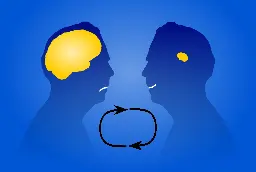Psychology
- 'Askers' vs. 'Guessers'
Are you an asker or a guesser? Short interesting read.
- I was the poster girl for OCD. Then I began to question everything I’d been told about mental illnesswww.theguardian.com I was the poster girl for OCD. Then I began to question everything I’d been told about mental illness
When I sought help for crippling invasive thoughts, I was told I had a disease like any other. But I wasn’t able to recover until I understood the fallacy at the heart of mental healthcare

- The Dunning-Kruger effect is not realeconomicsfromthetopdown.com The Dunning-Kruger Effect is Autocorrelation – Economics from the Top Down
Do unskilled people actually underestimate their incompetence?

Have you heard of the ‘Dunning-Kruger effect’? It’s the (apparent) tendency for unskilled people to overestimate their competence. Discovered in 1999 by psychologists Justin Kruger and David Dunning, the effect has since become famous.
Except there’s a problem.
The Dunning-Kruger effect also emerges from data in which it shouldn’t. For instance, if you carefully craft random data so that it does not contain a Dunning-Kruger effect, you will still find the effect. The reason turns out to be embarrassingly simple: the Dunning-Kruger effect has nothing to do with human psychology.1 It is a statistical artifact — a stunning example of autocorrelation.
EDIT: see response from dustyData and the article they linked to https://www.bps.org.uk/psychologist/dunning-kruger-effect-and-its-discontents
- The language you speak changes your perception of timewww.popsci.com The language you speak changes your perception of time
Different languages frame time differently. Read on.

- The Mystery of Sudden Geniuswww.psychologytoday.com The Mystery of Sudden Genius
Information that may exist in all brains but remains inaccessible, held back by inhibition.

- The psychology of impatience could make waiting more tolerablepsyche.co The psychology of impatience could make waiting more tolerable | Psyche Ideas
New studies on the experience of impatience suggest there’s more to it than simply how long you’ve been left hanging

- How Fear of Regret Influences Our Decisionsthereader.mitpress.mit.edu How Fear of Regret Influences Our Decisions
A simple dice game shines a bit of light on the psychology of regret.

- The Cybernetics of “Self”: A Theory of Alcoholism by Gregory Bateson
In which Bateson argues that the efficacy of Alcoholics Anonymous is (in a Western, Cartesian context) comes at least in part from providing a more correct epistemology/ontology that subsumes a reified "self" into a larger system/circuit. The alcoholic is, by "hitting bottom," forced to shift from a destructive symmetrical to a complementary pattern of relation with the system.
- Surprising Reasons Why Narcissists Like Conspiracy Theorieswww.psychologytoday.com Surprising Reasons Why Narcissists Like Conspiracy Theories
The belief in conspiracy theories may be related to personality traits.

- Perceptions of Falling Behind “Most White People”: Within-Group Status Comparisons Predict Fewer Positive Emotions and Worse Health Over Time Among White (but Not Black) Americans
Despite the persistence of anti-Black racism, White Americans report feeling worse off than Black Americans. We suggest that some White Americans may report low well-being despite high group-level status because of perceptions that they are falling behind their in-group. Using census-based quota sampling, we measured status comparisons and health among Black (N = 452, Wave 1) and White (N = 439, Wave 1) American adults over a period of 6 to 7 weeks. We found that Black and White Americans tended to make status comparisons within their own racial groups and that most Black participants felt better off than their racial group, whereas most White participants felt worse off than their racial group. Moreover, we found that White Americans’ perceptions of falling behind “most White people” predicted fewer positive emotions at a subsequent time, which predicted worse sleep quality and depressive symptoms in the future. Subjective within-group status did not have the same consequences among Black participants.
- Social Miracles As Hostage Exchangewww.overcomingbias.com Social Miracles As Hostage Exchange
My podcast co-host Agnes Callard points us to a striking phenomenon: social miracles: Sometimes you want something from someone, but you cannot see how they could possibly give it to you, because there appears to be a conceptual incoherence—something close to a contradiction—in the description you w...

- Williams syndrome is the genetic condition that makes people pathologically friendly — in a lonely worldwww.businessinsider.com Williams syndrome is the genetic condition that causes extreme friendliness — in a lonely world
Living with Williams syndrome makes people hypersocial in a world where loneliness is an epidemic. The rare condition's symptoms include extreme friendliness.

- The Philosophy of Humor: What Makes Something Funny?1000wordphilosophy.com The Philosophy of Humor: What Makes Something Funny?
What makes something funny? This essay reviews some theories of what it is for something to be funny.

- Neuroscientist Explains Why Donald Trump Supporters Cannot Change Their Minds About Himwww.askinweb.com Neuroscientist Explains Why Donald Trump Supporters Cannot Change Their Minds About Him
The approach to the 2024 election is taking shape, and it's clear that the upcoming political battle could have far-reaching consequences, both nationally and globally.

- The myth of the myth of learning stylesnedbatchelder.com The myth of the myth of learning styles
“Four different learning styles” has been debunked, but learners still have to learn how they learn, and choose the paths and materials that are right for them.
- Sexual arousal might not reduce pain in women, new study suggestswww.psypost.org Sexual arousal might not reduce pain in women, new study suggests
Contrary to previous male-centric studies, new research suggests that sexual arousal doesn't significantly reduce pain intensity or boost pain tolerance in women, with the erotic stimulus also potentially invoking feelings of disgust. This fresh insight, published in The Journal of Sex Research, und...

- Study confirms it: Opposites don't actually attractwww.sciencedaily.com Study confirms it: Opposites don't actually attract
A new study looked at more than 130 traits and involved millions of couples over more than a century. It found little evidence that opposites attract. Instead, for 82% to 89% of traits, partners tended to be similar.

- You Can Heal Even If Others Fail to Acknowledge Trauma

Online: Kaytee Gillis
Jessilyn slumped on the couch, eyes cast downward. "I heard from my mother last week," she said, her first time making eye contact since she had sat down 10 minutes before. I tried to hide my excitement at her willingness to go deep, instead trying to reflect a sense of neutrality and openness.
"We haven't talked in fifteen years. Maybe twenty," she began. "She left when I was about sixteen. My dad was violent, abusive really. He drank a lot. She couldn't handle it I guess, so she left. Last I knew she had remarried and had a couple other kids a few years back."
During this session with Jessilyn, she relayed a painful conversation with the mother who abandoned her when she needed her most:
I don't know why I opened this door. I knew it would upset me. But I asked her why she left so many years ago. I just came out and asked her. And do you know what she said to me? She said "you don't know how hard it was for me, Jessilyn. Living with that man. I just couldn't do it anymore.
Hard for her?! I thought. Like, she was an adult. She left a teenage girl who was barely able to drive, with this man who was so dangerous that she had to leave. What about me?!
But of course I didn't say this to her at first. I think I was in shock, honestly. She literally kept talking about how hard it was for her and how much better her life was once she got away, how much happier she is now... I couldn't even respond.
Most people would be able to see that Jessilyn's experience was traumatic. Being left with a parent who was abusive and violent, and being unable to escape, is unthinkable. Even though she was a teenager, and not a small child, this experience nonetheless changed - and completely traumatized- her. But still she spent years unable to see this experience for what it was. Instead internalizing the shame and self-blame in ways that she struggled to articulate. Her mother's refusal- or inability- to see her daughter's experiences as traumatic compounded her feelings of shame and reinforced the trauma she had experienced.
Eventually Jessilyn was able to ask her mom those terrifying three words: "what about me?" Her mom's response was that of shock and immediate denial. In her mother's eyes, she herself was the true (i.e. "only") victim of the violence and trauma within the home. During the very limited conversations that the mother and daughter had, Jessilyn's mother would say things such as "Your experience couldn't have been that bad, you turned out alright." or "You have no idea what I went through, you should be happy that I got out."
“She just won’t believe me! She can’t see what happened in my childhood and how that affects me today,” Jessilyn cried out from her spot across from me on the couch. “How do I move on if she can’t even understand the pain of my experiences, and how her leaving made it even worse for me?”
Many people come to me desperate to heal and move forward from their trauma history, yet struggling when it comes to convincing their caregivers what happened.
Sometimes, caregivers who also experienced trauma, such as in the case of Jessilyn's mother, are so stuck in their own experiences that they are unable to see the bigger picture.
In reality, Jessilyn's mother would not have to deny her own history in order to validate her daughter's. She could acknowledge her own experiences of abuse while recognizing that her daughter also experienced them- yet was powerless to leave due to being a child. However, mother was unable to focus on any reality other than her own.
Many of my clients get stuck trying to convince their caregivers of their pain because they believe they need that acknowledgement to heal. In truth, few will receive the validation they seek from their experiences this way.
This lack of validation can come from many sources, but it is often our caregivers’ own defense mechanisms keeping them in the denial stage—denial of their own actions (or inactions) but also denial of their own history of trauma that they unfortunately repeated. Shame comes in when confronted with the truth, and self-defenses take over in absence of self-esteem. They replace that shame with self-doubt, outward blame, and even rage.
This is where our own internal tools will need to take over and make up for that lack of external support and understanding from our caregivers so we can heal.
Remember, you do not need to convince others of your truth in order to move forward. No one has to acknowledge our mourning or grief for it to be authentic. Of course, this is easier said than done. Not being understood or believed comes with a feeling of invisibility, which compounds many survivors' trauma.
Instead, move towards self-validation. When working with clients with this experience, we focus on self-validation as a form of healing. Focus on acknowledging and validating your history. Whenever you feel the beginnings of denial or self-gaslighting creeping in, stop and say "no, I will not deny my history. What happened to me was traumatic, and I am allowed to feel this way." Validating your own history is a crucial part of the healing process.
Adapted, in part, from the book: Breaking the Cycle, the 6 Stages of Healing from Childhood Family Trauma.
Links:
psychologytoday/child-development
- Is Your Verbal Abuser Likely to Change?

Online: Harper Collins Author Profile
The foundation for verbal abuse in an adult-on-adult relationship is an imbalance of power; one person has it and is highly motivated to keep it and continue to control the relationship.
It’s important to remember that verbal abuse—whether it’s of the overt or covert variety—is highly motivated and goal-oriented as well as consistent, despite the fact there will likely be so-called “honeymoon” periods where the amount of abuse decreases or stops entirely.
While the person who is the target of the verbal abuse will likely believe that the respite reflects a change of heart on the abuser’s part, the sad truth is that it’s usually a tactic to keep the target emotionally confused and hopeful and, most important, fully committed to staying in the relationship.
Understanding the Imbalance of Power in an Abusive Relationship
While a healthy and satisfying adult relationship would be based on a partnership model, in verbally abusive relationships, one person seeks to maintain control. That’s made possible by certain factors such as these:
- One person has a greater emotional investment in the relationship than the other.
- The abuser exploits what he or she knows about the target’s insecurities and self-doubts to control the him or her.
- One person has greater financial resources than the other or the target is financially dependent on the abuser; each affects both the decision to stay or to leave.
- The abuser and the target have children and the target is concerned that any action of her/his part will involve the abuser’s retaliation and that the children will be hurt emotionally or psychologically.
Verbal Abuse can be Subtle or Covert to Maintain Control
The culture tends to picture verbal abuse as loud, involving yelling, put-downs, name-calling, and shaming; while verbal abuse certainly can and does take these forms, it’s the more subtle forms of verbal abuse that are more likely to entrap you and render you feeling powerless. That was certainly true for Casey, now 42:
“My ex-husband never raised his voice or called me a name; instead, he undermined me at every turn in subtle ways. Plans I’d made or initiated were always changed because he had a ‘better’ idea or solution that included everything from dinner reservations to renovating our kitchen and family vacations. He dismissed any complaints I had by telling me that I was ‘sensitive to rejection’ and that I was ‘emotionally over-reactive;’ it took me years to recognize that he was effectively shutting me up and shutting me down without ever saying so. There wasn’t a single domain in our lives where he didn’t insist on having the final say and, for a long time, I honestly believed that I had little or nothing of value to contribute to him or anyone. I went into therapy and when my counselor suggested I was being abused, I pushed back and denied it but it was the truth. When I tried to talk to him about it, he laughed at me and then refused to discuss it further. I was lucky, though. I ‘only’ wasted six years of my life with him.”
Among the more difficult-to-recognize forms of verbal abuse are:
- Blame-shifting: The abuser exploits your own self-doubts or insecurities by making whatever has happened your fault; that leaves the abuser with zero responsibility and more control and often makes you feel that you should apologize. A true sleight-of-hand.
- Brinksmanship: Threatening you with leaving or asking why you just don’t leave if you’re so unhappy. This is enabled by the abuser’s knowledge that you aren’t ready to give up on relationship and that you’re still hopeful a corner can be turned.
- Stonewalling or ignoring that you’ve said anything. This will put you into a defensive crouch and perhaps feeling panicked; this often ends up with your being a peacemaker and apologizing for something you didn’t do.
- Gaslighting: Telling you that your perceptions are dead wrong or that you’re projecting or making things up. Again, this preys on your insecurities as well as your hopefulness that things will get better somehow.
Will Your Abuser Ever Change?
Again, this comes down to motivation. We’ve seen how control is established through verbal abuse so the question becomes this: What’s in it for the abuser to stop?
If you find yourself in this situation, do speak to a counselor about strategies and what he or she thinks can happen given the nature of the relationship. Be cognizant of the possibility that confronting your verbal abuser may lead to escalation and remember that verbal abuse is always the foundation for physical abuse even if your relationship has never included it.
Do examine your expectations and ask yourself the following questions, answering as honestly as you can:
- Is he/she willing to acknowledge the verbal abuse without resorting to defensiveness or blame-shifting?
- Is he/she willing to hear you out thoughtfully without pushing back, dismissing your remarks, objecting, or starting a fight?
- Will he/she accept your pointing out verbal abuse and instituting respectful boundaries?
- Is he/she willing to go into counseling and commit to working on change?
- Is he/she willing to work on new ways of communicating and resolving conflict?
- Is he/she willing to commit to a partnership model of relationship?
- Is he/she willing to commit to a series of steps you mutually decide on if he/she backslides into old behaviors?
- If there are children involved and they have been targets, is he/she willing to apologize for past behaviors and willing to work on acquiring new parenting skills?
The truth is that if the answers to any of these questions is “no,” it will not be possible to repair or recover the relationship.
Psychologytoday.com/forgiveness
Psychologytoday.com/gaslighting
- Intuition - What It Is and How It Works

Intuition is the ability to understand something instinctively, without any need for conscious reasoning or an explanation. The use of intuition is sometimes referred to as responding to a "gut feeling" or "trusting your gut."
It's a phenomenon that many people experience, but its biological basis is still an area of ongoing research and exploration. Here, I will review some of the most relevant biological findings and address the question, "Can we really rely on intuition, or is it a counsel to failure?"
What the Research Says
Recent evidence from Universitat Pompeu Fabra, Barcelona, suggests that by 12 months, infants have an intuitive notion of probability that applies to never-experienced events and that they use it to predict subsequent events. The researchers suggest that extremely simple concepts of probability and causation, along with the concepts needed to form very basic epistemic (relating to knowledge or to the degree of its validation), statistical, and logical generalizations are present in very young children from an early age. It is this inborn ability to make inferences about things that are relevant to form accurate beliefs and retain new knowledge.
Rollin McCraty and his colleagues at the HeartMath Institute have performed experiments demonstrating how people respond to an emotionally arousing stimulus. The results were fascinating, showing that both the participants’ hearts and brains appeared to indicate receiving and responding to information about the emotional quality of pictures presented to them before a computer randomly selected them, as if they were responding to a future event.
Even more startling, perhaps, was data showing the heart received information before the brain. "It is first registered from the heart," Rollin McCraty explained, "then up to the brain (emotional and pre-frontal cortex), where we can logically relate what we are intuiting, then finally down to the gut (or where something stirs)."
The gut and the heart contain a significant amount of neural tissue and are connected to the brain by way of the vagus nerve, the so-called gut-brain and heart-brain axes. In addition, we know that neurotransmitters and hormones, such as dopamine and serotonin, can influence cognitive processes and emotions. These biochemical signals might also contribute to our intuitive responses.
Intuition relies on evolutionarily older, automatic, unconscious, and fast mental processing, primarily to save our brains time or energy. It also is prone to make mistakes, such as cognitive biases.
Intuition later in life arises from the accumulation of knowledge and experiences that are processed and stored in our brain's neural networks, as well as other cells and tissues in our bodies, allowing us to access this information quickly, often unconsciously.
Intuition is at the core of an epiphany; it is our own recognition and awareness of an idea or thought or vision for something that has yet to be discovered in the world. We all have access to that place, if we only learn to trust that internal voice.
Daniel Kahneman, who won a Nobel prize in economics for his work on human judgment and decision-making, theorizes that human beings are intuitive thinkers and that human intuition is imperfect, with the result that judgments and choices often deviate substantially from the predictions of normative statistical and economic models. Kahneman believes that intuitive thinking has both advantages and disadvantages: it is faster than a rational approach but more prone to error.
Kamila Malewska of the Poznán University of Economics and Business in Poland has studied intuition in real-world settings and concluded that people often apply a combination of strategies. When managers at a food company were asked how they use intuition in their everyday work, the majority of them said that, in addition to rational analyses, they relied on their gut feelings when making decisions. Interestingly, upper-level managers tended more toward intuition.
Malewska thinks that intuition is neither irrational nor the opposite of logic. Rather, it is a quicker and more automatic process that taps into the many deep resources of experience and knowledge that people have gathered over the course of their lives. Intuition, she believes, is an ability that can be trained and can play a constructive role in decision-making.
Intuition Essential Reads
Whether we rely on our intuition or turn to sensible analysis to make a decision will largely depend on our past experiences. Most cognitive scientists maintain that intuitive and analytic thinking should not be viewed as opposites. Studies indicate that our decision-making often works best when we blend both strategies.
Conclusion
Clearly, the biological basis of intuition is complex and likely involves a combination of factors. There is growing evidence suggesting that all humans are born with a basic ability for intuitive thinking and that, as we mature, as our links between the embodied mind, emotional processing, and intuitive thinking strengthen with experience, we may get better at it. Of course, if we fail to listen to this channel, like a muscle not exercised, our intuitive abilities will decline.
References
Cesana-Arlotti, N., Téglás, E., & Bonatti, L. L. (2012). The probable and the possible at 12 months: Intuitive reasoning about the uncertain future. Advances in child development and behavior, 43, 1-25.
Epstein, S. (2010). Demystifying intuition: What it is, what it does, and how it does it. Psychological Inquiry, 21(4), 295-312.
Fedyk, M., Kushnir, T., & Xu, F. (2019). Intuitive epistemology: Children’s theory of evidence. Advances in experimental philosophy of science, 122-43
Kahneman, Daniel (2017). Thinking, fast and slow.
Malewska, K. (2018). The profile of an intuitive decision maker and the use of intuition in decision-making practice. Management, 22(1).
McCraty, R., Atkinson, M., & Bradley, R. T. (2004). Electrophysiological evidence of intuition: Part 1. The surprising role of the heart. The Journal of Alternative & Complementary Medicine, 10(1), 133-143.
McCraty, R., Atkinson, M., & Bradley, R. T. (2004). Electrophysiological evidence of intuition: Part 2. A system-wide process?. The Journal of Alternative & Complementary Medicine, 10(2), 325-336.
- ADHD: Disentangling Genetic, Environmental, & Developmental Risk Factors—New Research Findings
Forwarded from Dr. Ken Pope with small edits to get under size limits.
-------- Forwarded Message -------- Subject: ADHD: Disentangling Genetic, Environmental, & Developmental Risk Factors—New Research Findings
The new issue of the American Journal of Psychiatry includes an article: “ADHD: The Mammoth Task of Disentangling Genetic, Environmental, and Developmental Risk Factors.”
Sarah Kittel-Schneider, M.D., is the author.
Here are some excerpts:
The first medical description of what is currently labeled attention deficit hyperactivity disorder (ADHD) was published as early as the 18th century
....
The underlying causes of ADHD, however, were unclear for nearly 200 years.
Since the beginning of the 21st century, it is largely validated that ADHD is a disorder with a heritability of about 80%, estimated from twin and family studies (4).
....
Polygenic risk scores (PRSs) summarize the risk alleles of an individual and weigh the effect size in an independent GWAS. Using PRSs seems to be useful to capture the synergistic effects of common risk variants of low effect sizes and to identify individuals carrying a higher genetic burden of those common variants (9). Moreover, more rare variants, such as copy number variants (CNVs), are also shown to play a role in ADHD pathogenesis, since there is a significantly increased burden in individuals with ADHD compared with the general population (10).
<snip>
Not only genetic but also environmental and developmental risk factors and their interaction are suggested to contribute to the onset of ADHD (11). But the investigation of the causality of environmental and developmental risk factors in ADHD is even more complex.
Earlier studies investigating, for example, the impact of smoking during pregnancy on ADHD risk in the exposed child often did not take the mother’s psychopathology or genetic risk into account (12). The same is true for the effect of breastfeeding on ADHD risk (13). Better-designed studies already hinted that the genetic risk of the mother might be the causal factor rather than the harmful effects of smoking in ADHD (14). Only few studies have been published so far looking at pregnant women with ADHD and mother-child interaction in early infancy in mothers (and fathers) with ADHD. Early data hint that women with ADHD are at a greater risk of smoking, drinking alcohol, and using illegal drugs as well as greater risk of pregnancy and birth complications, compared with the general population (15).
Therefore, it is highly challenging to disentangle the genetic from the environmental and developmental risk factors.
For example, preterm birth has been shown to have a relatively consistent association with an increased ADHD risk, but the direction of the effect is less clear (16). Does prematurity lead to ADHD symptoms, or do fetuses with a genetic ADHD risk tend to be born prematurely for unknown biological reasons? Or, as a third possibility, are mothers with ADHD more prone to give birth to premature infants as a result of increased psychosocial stress and unhealthy lifestyle and the causal link is rather the transmission of the genetic risk variants? Finally, is there an interaction or interplay between those different risk factors?
To make it even more complex, several potential environmental risk factors (in pregnancy or after birth) may also share genetic risk with ADHD, such as obesity, gestational diabetes mellitus, autoimmune disorders, allergic disorders, and so on, and there are hints that polygenic liability of ADHD is associated with an increased risk of exposure to environmental ADHD risk factors in individuals without an ADHD diagnosis as well.
A 2019 study by Leppert et al. (17) investigated mothers without a clinical ADHD diagnosis but carrying risk alleles associated with ADHD, compared with mothers without those risk alleles. Of most interest was the fact that the mothers with ADHD risk alleles had increased lifestyle-related negative exposures, such as more mental health issues and pregnancy complications and increased markers of unhealthy nutritional status. However, that study was unable to show a significant association of preterm birth with maternal ADHD genetic risk or with ADHD risk genes in the exposed children.
In this issue of the Journal, Brikell et al. (18) report on a study of the interaction between ADHD PRS, ADHD diagnosis, and environmental risk factors. They studied the association of 24 environmental and developmental risk factors and ADHD polygenic risk scores in a large cohort of 13,697 ADHD case subjects and 21,578 control subjects from a general population sample. There were three times more affected males than females in the sample, which needs to be mentioned, as we estimate that rates of adult ADHD are only 1.5 times higher in men compared with women in population-based studies. Brikell et al. included birth-related, somatic, and psychosocial risk factors, including parental mental disorder diagnoses, to evaluate potential gene-environment interactions. Not surprisingly, they could confirm a significant association of ADHD PRS with ADHD diagnosis. The higher the PRS burden, the greater the ADHD risk, which is confirmed in other studies (19). It is most interesting that in the general population sample, the authors could show a significant association of ADHD PRS with half of the 24 environmental risk factors. Small for gestational age, maternal autoimmune disorder, having had at least one infection, having had five or more infections, and a history of mild traumatic brain injury (TBI) were significantly associated. Furthermore, ADHD PRS was significantly associated with most of the psychosocial risk factors, such as income in the lowest quintile, low education level, living in a single-parent household during the first 5 years of life, being under age 20 at birth of index child, and parental history of mental disorder. Nineteen of the 24 risk factors were associated with a diagnosis of ADHD. The most significant associations were reported for low birth weight, epilepsy, and low parental education. Adjusting for ADHD PRS load and parental mental disorder diagnosis did not largely change the findings.
Surprisingly, Brikell et al. only found a tendency of gene-environment interaction between ADHD PRS and four of the 24 risk factors, namely, maternal autoimmune disease, TBI, paternal unemployment, and lower paternal age at birth of index child.
This suggests that individuals who are burdened with a higher ADHD PRS load and are additionally exposed to one of these four environmental risk factors might have a higher probability of developing ADHD.
The only gene-environment interaction that survived false discovery rate correction for multiple comparison, however, was the interaction of maternal autoimmune disease and high ADHD PRS load.
The results from the Brikell et al. study are very promising and point out the importance of what data should be included in future studies on the etiopathology of ADHD.
They strengthen the evidence of the heterogeneity of ADHD disease mechanisms and point toward the possibility of disentangling genetic and environmental risk factors as well as studying their complex interplay and interactions.
Recent studies give first hints as to how environmental factors can influence gene expression by changes in the epigenome, but this field is only in its infancy (20). More insight into ADHD pathomechanisms will reveal targetable risk factors that then can be addressed by interventions, and the causality will finally be proven in future interventional studies.
REPRINTS & OTHER CORRESPONDENCE: kittel_s@ukw.de.
Ken Pope
~~~~ Thank you Dr. Pope.
Merely forwarded by: Michael Reeder LCPC Baltimore, MD https://www.hygeiacounseling.com https://lem.clinicians-exchange.org https://mastodon.clinicians-exchange.org https://www.clinicians-exchange.org
